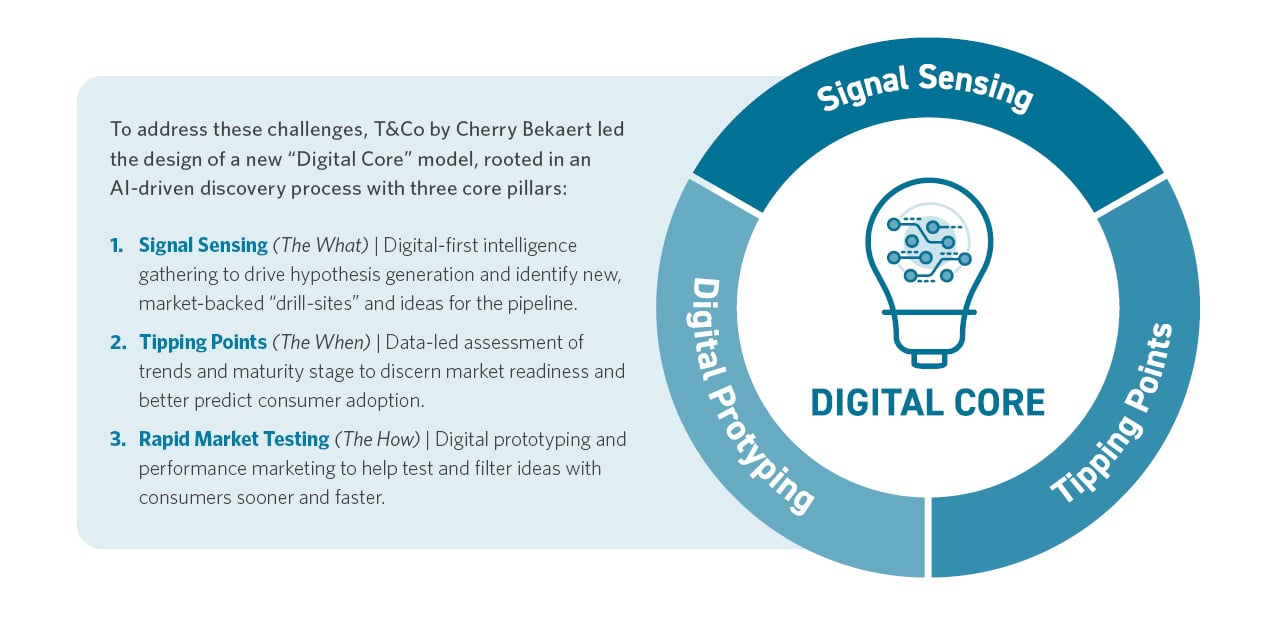Contributor:
Travis Sheldon | Senior Manager, Strategy Growth & Innovation
Faced with increasingly inconsistent innovation pipelines and mixed results in market, a leading consumer products company knew it needed to develop a radically different approach to innovation. The company partnered with Cherry Bekaert to upend decade-long practices by leading with artificial intelligence (AI) to design an entirely new model for research & development (R&D).
In 2022, a leading consumer products company came to terms with the need to rethink long-held ways of innovation. The century-old company had a long history of technology-led R&D, which had served it well in its journey.
From a small California-based company with one product, the institution is now a family of nearly 50 brands, with a presence in nine out of 10 U.S. households and operations spanning 26 countries.
Earlier, in 2020, as the COVID-19 pandemic spread around the world, the company doubled down on its technology spend and shifted focus away from new product innovation to process and manufacturing innovation. These investments served an acute need during the pandemic and allowed the company to meet unprecedented demand for its existing products. However, as the world settled into a new post-COVID normal and the need for new product innovation resurfaced, cracks in the established model for innovation also became more readily apparent. The company faced a lengthy discovery process, high resource needs, insufficient pipelines and mixed results in the market.
In late 2022, the company’s newly appointed chief R&D officer put forward an ambitious mandate to:
- Transform R&D to be leaner, faster and more consumer-driven; and
- Deliver bigger, stickier ideas more consistently to accelerate growth from innovation.
From his early days as an R&D scientist, the new chief R&D officer had grown up with the company and worked “every job in innovation.” He had been both successful with, and burned by, long-held, traditional methods for innovation. On the heels of the boom in AI, he knew the time to think radically was now. In 2023, he partnered with Cherry Bekaert on this new, ambitious undertaking.
A New Philosophy for R&D Discovery
Cherry Bekaert first led a rapid diagnostic of current innovation methods to:
- Identify key sources of value and waste across the R&D process; and
- Frame the most important strategic choices to address in defining a new R&D operating model.
This initial assessment allowed the company to create a clear innovation ambition and focus, from which emerged clear, no regret decisions related to R&D scope, portfolio structure and product development. As the revamped operating model started to take shape, it also became quickly evident that discovery, the stage in which R&D teams uncover and ideate against customers’ biggest needs and “jobs to be done,” would be the most critical stage to rethink through the lens of AI.
Lengthy timelines were a significant challenge in the discovery phase. The company’s R&D teams took an average of nine months to develop new ideas and take them to charter, or the go/no-go stage gate. Additionally, teams themselves were challenged by an insufficient appreciation of the right market and consumer signals to pay attention to and when to pay attention to these signals.
When taken in the context of a product portfolio concentrated in highly regulated categories with long lead times, these challenges resulted in a significant direct and indirect cost structure that did not consistently meet growth targets or deliver successful innovations to the market.
To address these challenges, Cherry Bekaert led the design of a new “Digital Discovery” model, rooted in an AI-driven discovery process with three core pillars:
- Signal Sensing (The What) | Digital-first intelligence gathering to drive hypothesis generation and identify new, market-backed “drill-sites” and ideas for the pipeline.
- Tipping Points (The When) | Data-led assessment of trends and maturity stage to discern market readiness and better predict consumer adoption.
- Rapid Market Testing (The How) | Digital prototyping and performance marketing to help test and filter ideas with consumers sooner and faster.
Central to this new Digital Discovery Model was a suite of emerging AI capabilities, which were not yet proven in the company’s core categories. Without the benefit of an existing precedent, Cherry Bekaert quickly defined the critical operating parameters, assessed the partner landscape, evaluated leading, in-market AI tools and designed potential models for engagement. Across the company’s biggest brands, pilots were then designed and ran to test, learn from and iterate on this model. The goal of these pilots was to land on a focused portfolio of AI solutions that could be easily tailored to the company’s different brands and markets.
In parallel, Cherry Bekaert also ran an overarching capability-building program, working closely with R&D leaders, brand leadership and AI vendors to design each solution. Discovery teams were coached throughout the pilots and initial rollout to capture earnings and feedback. Finally, the Digital Discovery Playbook was developed for the company to scale the new model across the rest of the global enterprise.

Results in the Field
Early results have quickly revealed and validated the power of the new Digital Discovery Model. Key takeaways about the model’s impact include:
- AI tools have enabled sensing across hundreds of millions of datapoints, as opposed to hundreds or thousands with traditional methods, to paint a more complete picture of the market.
- AI-enabled idea generation has allowed for more rapid concepting, with dynamic screening, scoring and prioritization.
- Digital prototyping and performance marketing has unlocked rapid in-market assessment and validation of potential concepts in just weeks.
- New agile ways of working have narrowed focus to essential activities and allowed for more rapid goal setting, tracking and course correction.
- Fewer and leaner R&D teams are now needed to identify and prioritize drill-sites and run potential concepts through the discovery process.
In less than one year from the mandate to develop a radically different approach to innovation, the company is already using the new AI-enabled Digital Discovery model to run end-to-end discovery with smaller R&D teams in under two months, as opposed to nine previously. As a result, previously empty innovation pipelines are being successfully replaced by market-backed portfolios of new ideas, ready for charter and activation.
The company is also running the new Digital Discovery Playbook across more brands to scale the Digital Discovery Model across the enterprise. As AI continues to disrupt industry after industry, the company is quickly rising to the forefront among its peers in redefining how businesses think about innovation in a world being transformed by AI.





